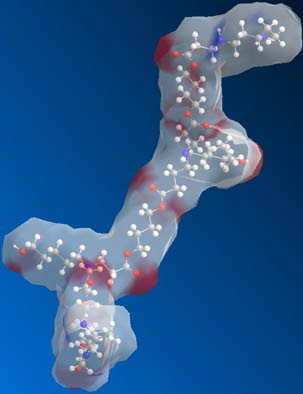Polymers that break down in the body will be used to transfer genes instead of viruses

Pictured: The structure of part of a biodegradable polymer used for gene transfer (by Jordan Green, MIT)
In research that may lead to safe and effective methods of gene medicine, researchers at MIT (Massachusetts Institute of Technology) have found a way to tune biodegradable polymers [1] to deliver genes.
In genetic medicine, new genes are inserted into the cells of patients, thus enabling them to fight diseases such as cancer. This field holds great promise, but is not yet realizing its full potential. One of the reasons for this is the issue of safety, due to the use of viruses to carry the genes.
The new research, published this week in Advanced Materials, focuses on creating new carriers for genes. These carriers will be made of synthetic and non-viral materials. The head of the research group is Daniel Anderson, a research associate at the MIT Cancer Research Center.
"We wanted to start with a very safe material - a biocompatible [2] and biodegradable polymer - and try to make it more effective, instead of starting with a virus and trying to make it safer," says Jordan Green, a research student in bioengineering and one of the lead authors of the article.
Genetic medicine has been the focus of intensive research for almost 20 years. Over a thousand clinical studies in genetic medicine have already been conducted, but as of today there is no genetic medicine procedure approved by the FDA - the American Food and Drug Administration. Most studies use viruses as carriers or vectors [3] for gene transfer. But there are risks involved in using viruses, so many researchers are trying to develop non-viral methods for transferring genes for the purpose of medical treatment.
The scientists from MIT focused on three molecules of poly(beta-amino esters) or chains of amine and diacrylate groups, which come one after the other on the chain. These polymers showed potential to be gene carriers. The researchers hoped to make the polymers even more effective by changing the ends of the polymer chains.
When the polymers are mixed together, they can spontaneously connect to DNA, creating nanoparticles. The nanoparticle, which consists of DNA and a polymer, can act in certain ways like an artificial virus and transfer DNA into cells when it is injected near or into the target tissue.
The researchers developed methods to improve new polymers and ways to test their ability to create DNA nanoparticles and transfer the DNA to the target tissue. For these needs, they changed the chemical composition of the ends of the biodegradable polymer chains, by using a pool of different small molecules.
"By changing just a few atoms at the end of a long polymer, you can change its performance significantly," says Anderson, "These marginal changes in the polymer's composition have greatly improved the polymers' ability to deliver DNA, and these new materials are currently the way to go." The most we have tested, for transferring DNA without viruses."
The polymers have already been tested on mice, and proven to be safe to use. The researchers hope to eventually run clinical trials with the improved polymers, according to Anderson.
Non-viral vectors may not only be safer than viruses, but also safer in some cases. The polymers can carry a larger load of DNA than viruses, and they may escape the attention of the immune system, which could allow the treatment to be repeated if necessary, according to Green.
One promising avenue of research is on ovarian cancer. The MIT researchers, in collaboration with Janet Sewicki of the Lancashire Institute for Medical Research, demonstrated that the polymer and DNA nanoparticles can deliver high levels of DNA to ovarian tumors without harming healthy tissue.
Other MIT researchers who contributed to the paper are Gregory Zogats (second lead author) Nathan Tedford, Professor Linda Griffith, Professor Douglas Lauffenberger, Professor Robert Langer, Janet Sewicki and Yu-Hang Yuang.
[1] - A biodegradable substance is a substance that breaks down in the body safely, within a relatively short time.
[2] - A biocompatible substance is a substance that is not harmful or toxic to the body.
[3] - A biological vector is usually an organism that transmits epidemics or infections - in other words, transmits foreign organic material to the body.
Links:

2 תגובות
Hello Roy
Very interesting, is it possible to get a link to the article?
It is very important.
If you want to genetically correct cells. 🙂